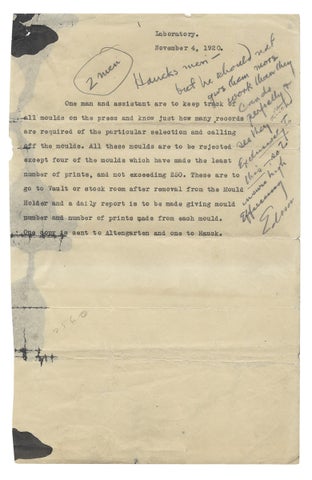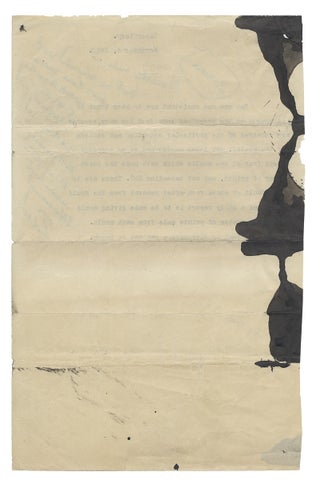1920 Thomas Alva Edison Signed Manuscript Laboratory Note.
“He should not give them more work than they can do perfectly…”
1920 Typed laboratory note by Thomas Edison, phonograph inventor, concerning moulds for his company’s proprietary “Edison Disc Phonograph” records. Edison gives detailed instructions on maintaining the quality of and the vault storage routines for the moulds used to “press” or make records, in pencil, in his own hand.
The typed portion of the note reads, in part: “One man and assistant are to keep track of all moulds on the press and know just how many records are required… All these moulds are to be rejected except four of the moulds which have made the least number of prints, and not exceeding 250.” It adds that the moulds are to be kept in the “Vault or stock room” and that daily pressing reports are to be made and “...sent to Altengarten and…Hauck.”
In his own hand, Edison appended and signed further instructions, stressing the need for perfection in doing this work. He writes, in full: “2 Men [these two words circled] Hauck’s men—but he should not give them more work than they can do perfectly & see they attend exclusively to this—so to ensure high efficiency. Edison.”
“Of all his inventions, Thomas A. Edison was most fond of the phonograph. As a result of his work on two other inventions, the telegraph and the telephone, Edison happened upon a way to record sound on tinfoil-coated cylinders in 1877. ... In 1887, Edison resumed work on his phonograph, using wax cylinders. Although initially used as a dictating machine for offices, the phonograph proved to be a popular form of entertainment, and Edison eventually offered a variety of recording selections to the public through his National Phonograph Company. Edison introduced improved phonograph models and cylinders over the years, ending with the Blue Amberol Record, an unbreakable cylinder with superior sound. In 1910, the company was reorganized into Thomas A. Edison, Inc. The Edison Disc Phonograph was developed in 1912 with the aim of competing in the popular disc market.”¹
A working laboratory note on phonograph recordings by iconic American inventor Thomas Edison, revealing his meticulous attention to procedure and business managerial efficiency.
Description: 1920 Thomas Alva Edison Signed Manuscript Laboratory Note.
[West Orange, New Jersey] Laboratory. November 4, 1920]. [1]p. Typed Note with Autograph Signed Annotations in pencil. Approx. 11 x 7 inches. Provenance: Mary Benjamin, successor of Walter R. Benjamin, Autographs. Left edge irregular and ink staining to verso and in left margin of recto, not affecting legibility and not touching autograph annotations or signature; now in archival mat and mylar sheet; Very Good.
[3727757]Note. 1. History of Edison Sound Recordings; Articles and Essays; Inventing Entertainment: The Early Motion Pictures and Sound Recordings of the Edison Companies; Digital Collections; Library of Congress accessed online. IB100
Price: $2,500.00

![[3727757] 1920 Thomas Alva Edison Signed Manuscript Laboratory Note. “Edison”, 1847–1931, Thomas Alva Edison.](https://rareamericana.cdn.bibliopolis.com/pictures/3727757.jpg?width=768&height=1000&fit=bounds&auto=webp&v=1645143614)

